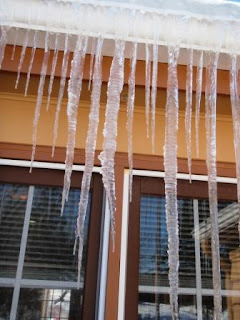Fresh snow, sunshine, and warmer temperatures this week have created fabulous icicles along the eaves of the office building roof here at Dodge Nature Center. Some are short, some smooth, some bumpy, some are long and thin, and some are curved. Right there in the middle of a row of straight icicles is one that is bent. Odd.
According to an article entitled “Why Icicles Are Long And Thin: Mathematical Physics Explains How Icicles Grow” (www.sciencedaily.com/videos/2007/0202-why_icicles_are_long_and_thin.htm), scientists have figured out a mathematical formula describing the process behind the formation of icicles. Basically, you start with melting snow. “As water drips onto an icicle and freezes, it releases heat. The warm air rises up the sides of the icicle. (University of Arizona Physicist Martin) Short says that warm air layer acts like a blanket that's an insulator, and so the blanket is very thin near the tip and thick at the top. That allows the top to grow very slowly and the tip to grow rapidly -- creating a long, thin icicle.” Kind of similar to how stalactites form in caves – only with calcium left behind as water evaporates.
So what makes some icicles bumpy and others curved? I didn’t find anything that specifically, scientifically answered the question, but wind must play a role. That’s how you get variety like these icicles on the office building.
Read more about how icicles form at these websites:
Icicle Formation Mystery Solved
Snowy Science Lessons by Jack Williams


No comments:
Post a Comment